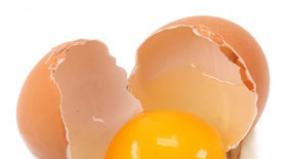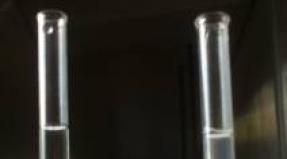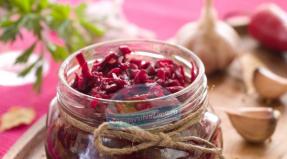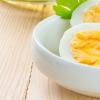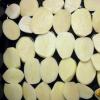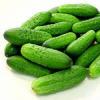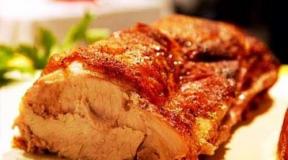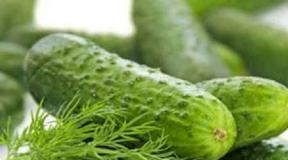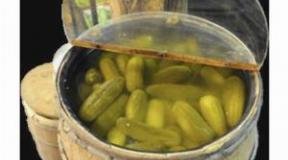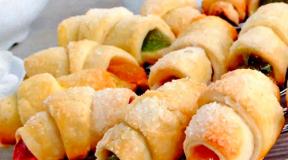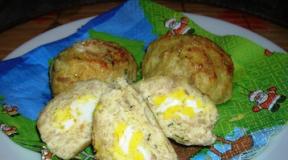Pickles from vegetables. Souring and salting vegetables
Vegetables are best sour in wooden barrels. Before fermenting vegetables, the barrels should be soaked, so that the wood swelled and there were no cracks in the barrels. After soaking, thoroughly rinse the barrels and treat with caustic soda solution: dissolve 100 g of soda in 30 liters of hot water.
CROWD CABBAGE
Medium and late cabbage varieties are suitable for souring. Heads must be fresh, dense, large. When cleaning heads, remove the top, green and damaged leaves, level with the head of cabbage cut. Cut the head of cabbage into 4 parts and cut the stalk. Then, by machine or knife, chop the cabbage into strips of 5 mm. For 10 kg of slaw, you need 200 g of salt, 350 g of carrots, 1 kg of apples. Peeled carrots cut into slices, apples - quarters. At the bottom of the container put a layer of clean cabbage leaves, then a layer of slaw, which in advance in a separate bowl, mix with carrots and apples. Lay it in layers until the container is full. Cover the top layer of cabbage with a layer of whole leaves, put a wooden circle on top with a load of clean washed stones. Together with the slaw, you can put whole heads of cabbages and half heads of cabbages in barrels.
Immediately after laying cabbage fermentation begins. Cabbage leave in a room at a temperature of 10–20 ° C. It is necessary several times to pierce the cabbage with a wooden stick and remove the foam formed on the surface. After 10–12 days, the fermentation ends, and the cabbage can be brought to the cold. After a month or two you can eat cabbage. If you store cabbage on the balcony, before the cold, arrange it in plastic bags and bring the right amount of bags into the room for defrosting.
CROWD CABBAGE
Chop cabbage finely with a grater or knife, sprinkle with salt, mash on the table, add carrots chopped on a coarse grater.
Lay in a 3-liter jar, well tamped with a hand before selecting the juice. Excess juice is poured into a jar, stored in a cool place. We close the cabbage-filled jars with cabbage leaves and leave them on the fermentation table for 3-4 days in the kitchen. After 4 days, make 2-3 punctures with a wooden stick to the bottom to remove the gas. After the puncture, add the remaining juice to the jar, then add 1 tablespoon of vodka to each jar (so that the cabbage does not turn sour), close the jars with lids and place them in the cold (cellar, refrigerator, etc.). A 3-liter jar requires 3.5 kg of cabbage, 2 tablespoons of salt (with a slide), 4 large carrot roots. The cabbage turns out great taste and can be stored until the summer of next year.
Cucumber
For pickling, select cucumbers that are not fully ripened with dense pulp. Yellow, beaten, crushed for pickling are not suitable. Small cucumbers salt separately from the large. After sorting, wash the cucumbers thoroughly in clean water and put them in a barrel. Together with cucumbers, add spices and herbs: dill, garlic, horseradish, chilli pepper. Chop the spices beforehand. For 100 kg of cucumbers you need to add 3 kg of dill, 300 g of garlic, 500 g of horseradish roots, 100 g of paprika. You can also add black currant leaves, parsley, celery. Just keep in mind that the total mass of spices should not exceed 5%.
Put cucumbers in a barrel and sprinkled with spices, pour brine (7 kg of pure edible salt per 100 l of water). Strain the brine before pouring. Close the barrel and leave it in the room. After two days, when the cucumbers will salt a little, move them to a cold room, preferably on a glacier. In a month or two, the cucumbers will be tasty and crispy.
If a mold appears on the brine surface during storage of cucumbers, pour a little dry mustard powder - the mold will not develop.
You can pickle cucumbers in an enamel saucepan. The principle of salting is the same as in the barrel. Put cucumbers and spices in a saucepan, cover with brine. Top with a wooden circle with a load. The circle should be immersed in brine. Soak it all for a few days in the room, and then transfer to the cold.
VEGETATION OF TOMATOES
Tomatoes can be salted in any variety, any form, different stages of maturity. Red tomatoes soften when salted, so they are best salted in three-liter glass jars, and green and brown can be salted in barrels.
Brine for pouring green and brown tomatoes is prepared at the rate of 7 kg of salt per 100 liters of water, and for red and pink tomatoes - 10 kg of salt per 100 liters of water. When salting tomatoes in the barrel add dill, horseradish leaves, black currant. Tomatoes, salted in jars, cork tin lacquered lids after 10-day fermentation in uncorked form. Salted tomatoes, as well as cucumbers, store in the cold.
SALT GREEN
Greens (young dill, parsley, celery) chop and mix with clean dry salt in relation to 8 parts of greens and 2 parts of salt. Put this mixture in glass jars and tamp before juice appears. High salt concentration will not allow microorganisms to develop. Salty greens retain their original color and natural aroma. Banks with greens leave in the room for 2 days, during which time the greens will settle; Fill the jars to the top, taking greens from other cans. Then seal the jars and store them in a cool place.
CANNING CANCERS
Sort the cucumbers by size and soak in cold water for 5 to 5 hours, then wash thoroughly. Rinse the spices (horseradish celery, dill, parsley, garlic) and chop. Put a handful of the mixture on the bottom of the jar with a layer of 1–1.5 cm (in a loose state), and also 10–15 grains of black pepper, 1 bay leaf. Then, lay the cucumbers firmly upright. Place the same amount of spices on top of the cucumbers as on the bottom. Per 1 liter jar consumed 30-35 g of spices. Small cucumbers canned in liter jars, large - in two-and three-liter. Fill should contain 6% salt and 12% acetic essence and be not lower than 70 ° С. Then cork cucumber bottles and sterilize for 3-5 minutes, two and three liters - 10 minutes, counting from the moment of boiling water.
CANNING OF TOMATOES
Pick up red tomatoes, dense and identical in size, rinse and put in jars. Fill with boiling brine (for 1 l of water - 35 g of salt and 6 g of citric acid). Cover the jars with lids and put on heating, keeping in boiling water: liter - 5–8 minutes, three-liter - 15 minutes. Then seal and cool.
TOMATOES IN OWN JUICE
Peel off the selected prepared tomatoes. To do this, put them in a colander and for 1-2 minutes. Dip in boiling water, then quickly immerse for 2-3 minutes. in cold water - the peel is easily removed. Prepare tomato juice: chop overripe tomatoes, put in a saucepan and, stirring, boil for 5–10 minutes, hot rub through a sieve and heat again. Rinse the peeled, prepared for canning tomatoes with water and place in jars, pour them with hot tomato juice, to which add 1 g of salt, 1.5 g of citric acid, 10 g of sugar to 1 liter. Cover the jars with lids and warm them, keeping half-liter jars in low-boiling water for 4–5 min., Liter jars for 8–9 min., Then seal and cool.
One liter jar will need: red peeled tomatoes - 700 g, salt - 10 g, tomato juice for pouring - 340 g, citric acid - 1.5 g.
CANNING OF TOMATOES
At the bottom of a 3-liter jar put 3 cloves of garlic, cut into pieces, 2 seed umbel fennel (without stalks), 1 sprig of celery and 1 sprig of basil. Laying a full can of tomatoes (green, brown or red). Top we add 2 large cloves of garlic, 2 umbels of dill and pour boiling brine: for 1.5 liters of water, 2 tablespoons of salt (with a hill), 3 tablespoons of granulated sugar (with a small hill), 5 allspice of allspice and 1 bay leaf medium size. Fill with brine for 5-7 minutes. Then pour, bring the brine to a boil and pour it again, add 1 tablespoon of 9% vinegar, close the lid. After cooling set in a cool place. When stored in room conditions, pour the jar three times with boiling brine with an interval of 5-7 minutes and add 2 tablespoons of vinegar.
CANNING OF TOMATOES WITH FRUITS
Often canned tomatoes in the banks of the lope. We recommend canning red tomatoes with stems. Fill the jar with tomatoes and herbs: dill, basil, celery. Fill with boiling brine: for 1.5 liters of water, 2 tablespoons of salt (with a slide), 4 tablespoons of granulated sugar, 3 pcs. carnations. After 15 minutes, the brine is poured, boiled, again we pour tomatoes on it, add 2 dessert spoons of acetic acid and roll up the jar.
Cucumber
At the bottom of a 3-liter jar put one seed umbrella of dill, then lay a layer of cucumbers vertically, add 3 leaves of cherry, 3 leaves of black currant, 3 cloves of garlic, 6 peas allspice, umbrella of dill, a small sheet of horseradish, then fill the jar with cucumbers and on top put an umbrella of dill. Fill cucumbers with boiling brine: for 1.5 liters of water, 2 tablespoons of salt (with a slide) and 1 bay leaf of medium size. Cover with deep plastic caps taken out of hot water, or roll metal caps. Store in a cold place (cellar, refrigerator).
CANNING CANCERS
At the bottom of a 3-liter jar we place 2 large garlic cloves, a seed umbrella of dill (without stalks), lay a full jar of cucumbers, add 1-2 umbrellas of dill and 2 cut garlic cloves on top. Fill with boiling brine: for 1.5 liters of water, 2 tablespoons of salt (with a slide) and 2 tablespoons of granulated sugar, 3-5 peas of allspice. After five minutes, the brine is drained, brought to a boil and re-poured, while adding a full tablespoon of 9% vinegar to the jar, closing with any lids. For storage under room conditions, pour three times with boiling brine at intervals of 5 minutes and add 2 tablespoons of vinegar.
LITTLE CUCUMBERS
In a 3-liter jar we put 3 umbels of fennel (with ripened seeds), 5 leaves of black currant, 5 leaves of cherry, horseradish leaf, 5 cloves of garlic and 1.5 kg of cucumbers, all interspersed. Fill with boiling brine: for 2 liters of water, 2 matchboxes of salt (with a slide) and 2 teaspoons of granulated sugar with a slide. We close the cans with light plates and leave for three days in room conditions until the mole-acid fermentation is done. Remove the foam, close the jar with a plastic lid and put in the refrigerator or cellar. Cucumbers are salted, tasty, crunchy, but not for long storage.
For winter storage, the brine after fermentation is poured into a saucepan, brought to a boil, and again pour cucumbers, close.
If this article on our site was useful for you, then we offer you a book with Recipes for Living, Healthful Nutrition. Vegan and raw food recipes. And also we offer you a selection of the best materials of our site according to our readers. Selection - TOP of the best articles about healthy living healthy eating you can find where you are most comfortablePreparations of summer vegetables for the winter can be carried out almost the entire summer. There are several ways to preserve their taste and other qualities. It is freezing, pickling and salting. Let's stop on the last version.
Salting vegetables is practiced for more than the first century. This product is a very popular snack, but not many people know that salted vegetables (in reasonable quantities) are still quite a useful product and are part of a healthy diet.
Salty vegetables are well suited for a variety of diets. This is due to the fact that they contain a small amount of calories, fat and sugar. In addition, salted vegetables are a real warehouse of fiber, which is necessary for the normal functioning of the entire digestive system.
Many vegetables, especially cucumbers and tomatoes, contain the so-called antioxidants - elements that fight free radicals. And, of course, depending on the specific type of vegetables, they may contain calcium, iron, magnesium and many other useful substances for the body.
But we must not forget about the spices and spices that make up the brine, they also give a lot of their useful properties. For example, garlic and dill perfectly regulate the growth of bacteria, mustard seeds have a positive effect on digestion.
The main ingredient in salted vegetables is brine, it is better to prepare it in advance. The amount of pickle depends on the amount of salted vegetables. If you produce a blank in cans, then it can be prepared as follows. Cold, unboiled water is poured into a stainless or enameled container and a certain amount of salt is added to it. That's all.
However, it should be noted that brine of different concentration is used for salting different products. For example, for cucumbers, the optimal ratio is 6% salt per 100 units of water. That is, if you need 3 liters of brine, you will need about 200-220 grams of salt.
It is best to use the so-called coarse rock salt. For tomatoes, the best proportion of salt is 70 grams per liter of water. And if you are going to pickle whole white cabbage, the salt content in brine increases to 90-95 grams per 1 liter of water.
In order to properly pickle vegetables, you need to follow a few simple rules. Choose only whole, non-defective vegetables, they should be of suitable (usually small) size and be fresh (the latter is especially important for cucumbers). Below are some examples of salting.
Cucumbers
As mentioned above, for salting is better to use the freshest cucumbers. Having lain even a couple of hours in the refrigerator, they can become unsuitable for the preparation of a quality product. The size of cucumbers does not matter and is selected depending on your preferences.
Carefully inspect them; there should be no dark or yellow spots on the cucumbers, as well as traces of rot. After that, rinse the vegetables and cook for salting. Of course, barrel cucumbers are most famous, but we will not go into the technology of preparing barrels for salting. Consider an option that is acceptable for use in any apartment.
At the bottom of a 3 liter jar are laid the stalks of dill, black currant leaves or grapes. Add a few cloves of garlic and sweet peas. After that the selected cucumbers are laid. The final touch is pouring 6% saline brine. The can is closed with a plastic cap and placed in its storage location.

Zucchini
For salting zucchini it is best to use young, small-sized specimens, the optimal length is up to 10 centimeters. The fact is that such zucchini has a delicate skin and not yet formed seeds. This has a very positive effect on the taste of the finished product.
Selected zucchini are washed under running water, the stalk and dry inflorescences are separated from them. Putting zucchini in a container for salting is necessary in layers. The first layer consists of cherry leaves, chopped horseradish and parsley. The next layer is laid zucchini. Then everything repeats from the beginning, and so on until the tank is completely filled.
Prepared 5% salt solution, after complete dissolution, it must be filtered through folded three times gauze and pour into a container with zucchini. The resulting pickles are placed in a dark cool place.

Tomatoes
In order to pickle tomatoes, you can choose both red and green fruits. Tomato peel should not be damaged or dented. Selected vegetables are thoroughly washed with water.
As seasonings and spices for pickling, currant leaves, horseradish or cherry are well suited. In addition, the taste of tomatoes is well set off by garlic, dill, rosemary, savory, tarragon, cloves, red and black pepper, cinnamon and celery.
If you salt green tomatoes, the brine should be prepared at the rate of 60 grams of salt per 1 liter of water. In that case, if you have red or brown tomatoes at your disposal, the concentration increases slightly and is approximately 70 grams per 1 liter of water. Sometimes sugar is added to the pickle for tomatoes; this is due to the fact that fermentation occurs faster with it and acidity decreases.
In order for the fruits of the tomatoes not to be cracked during storage, before pouring the brine, it is necessary to pierce their skin several times near the stem. It is best to store salted tomatoes in a dark place at a temperature of 1 to 6 degrees. The best option would be a small cellar, but in the absence of such a simple refrigerator would also do.
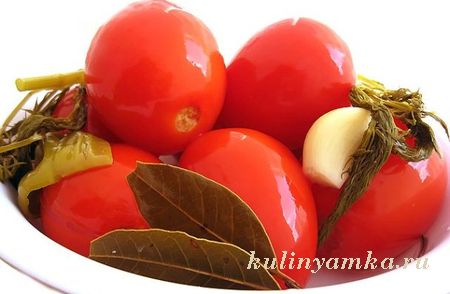
Opportunities for salting vegetables are not limited to the options listed. Virtually any kind of vegetables can be cooked using this method. If you experiment a little, you can find or come up with your own, not like the rest of the recipe, which will fully meet your gastronomic needs.
- This is the most reliable, simple and popular way to preserve the crop. Salt and lactic acid are preservative substances at salting. They protect vegetables from spoilage and delay the development of harmful microorganisms. In addition, it is lactic acid that gives vegetables a specific flavor. So, we harvest vegetables for the winter using the salting method!
Salting vegetables for the winter. Recipe with photos for tomatoes
Tomatoes are those vegetables that are the most popular in winter harvesting. Only cucumbers can compete with them. Tomatoes are salted with different methods. But consider the cold salting method. For harvesting selected tomatoes of any shape, of any variety and of different degrees of ripeness. True red tomatoes become too soft when pickled; therefore, saline them better in three-liter glass jars. Brown and green tomatoes can be salted in the sides, in buckets, etc.
Brine for salting red and pink tomatoes is prepared in the calculation of 1 kg of salt per 10 liters of water, and for green and brown tomatoes - 0.7 kg of salt per 10 liters of water. When salted, greens, dill umbrellas, black currant leaves, horseradish leaves and roots are laid in the container for tomatoes. Tomatoes in cans are poured with cold pickle and left for fermentation uncorked in a cool place for 10 days. Having checked salted tomatoes in jars for readiness, they should be hermetically sealed with metal lids. Store salted tomatoes in a cool place.
In addition to cold pickles, also applies to tomatoes. But this method is more laborious, as it requires repeated, short-time infusion of tomatoes poured with hot pickle, followed by draining and reheating.

Salting cucumbers
“Cucumbers. Salting vegetables for the winter "recipes not inferior in demand for tomatoes. For salting, per 10 kg of cucumber, 0.3 kg of dill greens, 50 g of horseradish roots, 50 g of garlic, 10 g of hot peppers are taken. To your own taste, you can additionally pick up the roots and greens. Greens, it is desirable to use fresh, washing it before laying under cold water. The total weight of spices and greens should not exceed 6% by weight of cucumbers.
Washed and drained cucumbers are packed tightly in cans (preferably vertically). Rows of cucumbers need to shift the spices and pour boiled brine, prepared from 10 liters of water and 0.6-0.7 kg of salt. Before pouring the brine be sure to strain. Greens - put on the bottom of the cans, and on top - cucumbers. After the can, it should stand for 3-4 days at home and, when the cucumbers are salted, transfer the container to a cooler place, covering the cans with nylon caps.
Salting cucumbers must be kept in the cold; even a little frost will not hurt them. In the heat, they quickly turn sour and deteriorate.

Salting vegetables for the winter recipe for squash and squash
For salting zucchini and squash should be moderately mature, with dense flesh and delicate skin. But by no means overripe! Before salting, the vegetables are washed out in cold water, the tops are cut off from them, and after the vegetables they are picked up with a wooden skewer in several places. Then the zucchini are stacked tightly to each other in rows, and between them is laid greens: celery, dill, cherry leaves and black currants, tarragon, parsley. Spicy spices when salting zucchini and squash can be 1.5-2 times more than the vegetables themselves. Next, pour the brine, prepared in the calculation: 1 liter of water - 60-80 g of salt. Squashes are covered and left to ferment and mollify for 5-7 days. After they need to be moved to a cold place for long-term storage.

Salting watermelons
Of course, watermelon (as many know) is not a vegetable, but a berry. But since it is harvested in the winter by salting, then it can be safely categorized as salting vegetables. Only fine-grained, mature watermelons of small size (up to 2 kg) are suitable for salting. The best period for salting watermelons is September-October, since they must be stored at low temperatures, otherwise they will ferment quickly.
Salt watermelons can be as follows. Watermelons are sorted, washed and punctured in several places (to accelerate fermentation). Then the watermelons fit tightly into a suitable container (for example, in a barrel) and are poured with brine (60-80 g of salt is taken for 1 l of water), then covered with a lid and kept for 2-3 days at a temperature of about 20 C. Then the container moves in a room with a lower temperature, topping up the brine if necessary and covering it tightly with a lid. The favorable temperature for storing salty watermelons is +1 ... -10 C. On average, the fermentation process lasts 15-20 days, and these can be tried.

Salting vegetables for the winter. Step by step recipe onions
In onions, you can pickle feathers and turnips. In the first case, green onions are removed, removing the affected, flaccid and dried feathers. After fresh greens, they are washed and cut into pieces 2-3 cm long. Cut onion feathers are put in jars as tightly as possible, and bay leaf, allspice are added to them, salt is poured (about 5-7% of the total onion mass). Banks are covered not too tightly with nylon covers, left in a cool place to “ripen” and in 2-3 weeks you can try the blank.
For pickling onion turnips, it is better to select small, immature bulbs. They should be cleaned, washed in cold water and, like the greens, put in jars with spices (but without salt). After the brine is poured into the jars (100 g of salt per 1 l of water) and the vegetables are kept at room temperature for 5-6 days. For storage, salted onions must be transferred to the cold.

Salted carrots
For salting, carrots of table varieties with a small heart, red-orange color are suitable. Pre-root vegetables are thoroughly washed out with a little bud, and the tops of them are cut off; blackened places should be cut out. Then the carrot is placed in a suitable container, filled with brine (60 g of salt per 1 liter of water) and covered with a clean linen cloth. A yoke is put on top, so that the pickle completely covers the carrots. The billet for the initial fermentation is kept in a room for 4-5 days, and then placed in a cool place. In the same way you can pickle carrots, sliced into circles or strips.
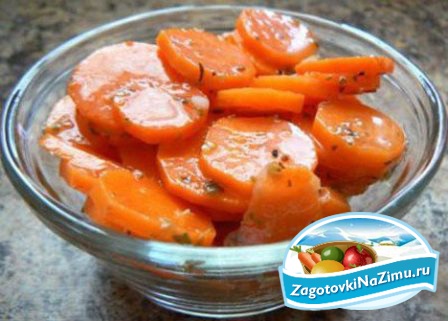
Salt can be almost all vegetables. For example, salty green beans and sweet peppers, garlic and eggplants, turnips and pumpkins turn out to be extremely tasty ... At the same time, this is not at all a complicated matter! And you can stock up vegetables for the winter!
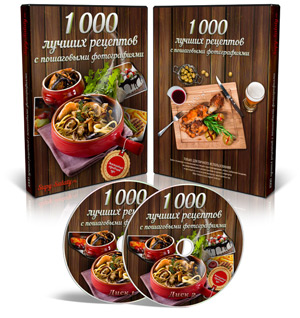
Especially for you, our site has prepared a training course on 2 discs "1000 best photo recipes."
In this course, we have collected for you 1000 detailed photo recipes from our site on various culinary themes.
More information about the course content you can find.
Preparations for the winter require a lot of time, effort and skill. But they are worth it, because in the winter cold evenings salty and pickled vegetables, jams and compotes are always on the table. Enjoy pickles and jams, remembering the summer over a family dinner - what could be better! In this article you will find vegetable pickles recipes and conservation tips
Today, supermarket shelves are filled with colorful jars with pretty pickled and canned cucumbers and tomatoes, but despite this, many experienced (and not very) culinary experts prefer to make pickles on their own. The process is time-consuming and troublesome, but how much pleasure in the winter can a crispy cucumber bring with a bit of steaming potatoes ... Imagined ?! Ready for action ?! Then go to the bazaar.
DRESS CODE
Choosing vegetables like “Our Father” we remember that only strong, ripe fruits are good for salting (if the recipe does not provide for unripe or overripe), without damage, spoils and dents. After bringing the vegetables home, we sort them by size, quality, degree of maturity and soak them in cold water for several hours. Then we wash it very well and process it (cleaning, cutting, blanching). Next comes the turn to take care of the packaging.
A drop of microbes
For the storage of pickled stocks used various utensils: wooden, glass, enameled. The most running at home - a glass jar. However, in order to begin to fill it with a future marinated yummy, first we will survive all the germs from it. This is done simply: the banks are thoroughly washed with hot water with baking soda and soap, and then boiled for 10–15 minutes. The same procedure and pass the cover, which will later be sealed banks. By the way, lids made of tinned and lacquered tin with rubber gasket are suitable for our purposes - to create a sealed environment in a jar of pickles. It is better not to use covers of unvarnished tin, especially for sealing canned sour fruits and berries - it will quickly oxidize and the taste of preservation will deteriorate. You can sterilize the jar with an ordinary kettle. To do this, it is enough to boil water in it and, having attached the jar to the spout, let it boil. For these purposes, you can use the oven. The washed and dry jars are put into it, then the oven heats up and after 30 minutes the jars are “ready”. "Baked" so the jars are quickly filled with vegetables (not yet cooled) and poured with brine.
Attention! Before you attach the jar on the spout of the kettle, you need to wrap it with a cloth. Remember: if glass is in contact with hot metal during sterilization, it will burst.
SAVIOR OF HUMMER MORNING
The quality of brine directly depends on the quality of water. Experienced chefs recommend using spring or well water for this purpose, however, the conditions of the city make adjustments. If there is no well, you will have to be content with what is flowing from the tap - ordinary tap water. It is better to let it through the filter, boil it or, alternatively, let it stand for a day.
The next component, without which brine is impossible, is salt. For pickles, large rock salt is most suitable. Fans of the iodinated version will have to sacrifice their preferences this time - iodine gives the fruit an unpleasant taste.
RESPONSIBLE PROCESS
However, filling a can with vegetables and pouring them with marinade is only half the battle. Next, you need to subject canned sterilization. To do this, a towel is placed in a large saucepan, jars (not rolled up!) Are put on it, cans are poured, water is poured and the whole structure is set on fire. At this time, you need to make sure that the lids do not move, and the water in the pan was at the level of the marinade in the jars. As soon as the water boils and begins to gurgle softly, turn down the heat so that the boil is barely noticeable and close the pan with a lid. In this position, liter jars are left for 12 minutes, and then we take out, roll it up and put it neck down on a towel to cool it. When the preservation is cooled, transfer it to a cool place where it will be stored.
Attention! Do not be lazy for each batch of cans to pour new water, as if you put a cold jar in hot water, it will burst.
Despite the fact that each housewife has her own, favorite way to pickle vegetables, we suggest that you fill up your prescription book with a couple of our recipes.
Piculi
Cucumbers (small) - 25 pcs.
Tomatoes (small) - 20 pcs.
Carrots (sweet) - 5 pcs.
Cauliflower - 1 pc.
Zucchini (small) - 2 pcs.
Onions (small) - 25 pcs.
Garlic - 25 teeth
Bulgarian pepper - 5 pcs.
Celery (stem without leaves) - 1 pc.
Parsley (stem without leaves) - 1 pc.
Dill (stem and dried inflorescences) - to taste
Apple Antonov - 1 pc.
Black currant (leaves) - to taste
Cherry (sprigs with leaves) - to taste
Water - 2 l
Sugar - 120 g
Salt - 130 g
Vinegar spirit 6% - 200 g
Bay leaves - 5 pcs.
Carnation - 5 pcs.
Black pepper peas - 15 pcs.
Bank (1 l) - 5 pcs.
All vegetables are washed. We clean the carrots and onions, remove the seed part from the pepper. We divide the cauliflower into florets, cut carrots and zucchini into circles, put the vegetables in a colander and put them in boiling water for 3-4 minutes. Greens cut into slices of 3-4 cm. If the vegetables are large, then cut them into beautiful slices, and if small, leave them whole. We remove the seeds from the apple and cut it into medium-sized slices. Pepper cut into strips.
Combine water with sugar and salt, bring to a boil and filter through the canvas. After once again bring to a boil and before removing from heat, add vinegar and spices.
At the bottom of a boiled jar we place a sprig of black currant, a leaf of a cherry, a dry fennel inflorescence, a handful of chopped greens and a slice of Antonov apple. Then we spread the vegetables (they should be distributed in a jar tightly): five cucumbers, four tomatoes, cauliflower, carrot and zucchini slices, onions, garlic, pepper strips, celery stalks and dill. On top we place a currant leaf with a sprig, a handful of greenery, a fennel inflorescence, one bay leaf, a clove and three peppercorns.
Pour hot marinade into the jar, cover with boiled lid and sterilize for 12 minutes from the moment of boiling water. After the lid we twist it with the help of a seamer and place the jar with its neck down on a towel. After 15 minutes, slightly cooled jar is placed in a basin with warm water and gradually begin to scoop it out, replacing warm water in the basin with cold one. Then put the jar under running cold water. In an hour, she will be completely cold. Rapid cooling will make pickles more tasty, and cucumbers - stronger and crunchy.
Pickles
Cucumbers (small) - 10 kg
Water - 10 l
Salt - 600 g
Dill (inflorescence) - 300 g
Black currant (leaves) - 50 g
Tarragon - 50 g
Cherry (leaves) - 50 g
Horseradish (rhizome) - 60 g
Garlic - 30 g
Hot peppers - 10 g
To cook canned cucumbers, soak cucumbers in cold water for 5-6 hours, then rinse thoroughly, pour boiling water and, while they are still warm, put them into prepared jars, shifting them with layers of spices. Close the dishes with cucumbers for 5-6 hours so that they absorb the smell of spices. Then we mix water with salt, bring to a boil, cool and pour cucumbers into the resulting brine. Put garlic and hot pepper to taste, press down on top, wrapped in a clean cloth, with a wooden circle and load, and leave the pickles for two to three days at room temperature to start lactic acid fermentation, and then bring them to the basement. As the foam appears, the circle and the load should be washed. You can eat canned cucumbers for any dish.
Eggplant Salted
Eggplant (ripe, elastic, medium size) - 10 kg
Dill (greens) - 350 g
Tarragon - 350 g
Water - 2 l
Salt - 120 g
Garlic - 100 g
Horseradish - 100 g
Savory - 100 g
Basil - 100 g
Cinnamon - 100 g
Cloves - 100 g
Fruits are carefully washed and remove their stalks. Eggplant is cut along about 2/3 of the length and tightly laid in a container for salting, shifting the branches of dill and tarragon. Mix water with salt, bring to a boil, put in a pickle garlic cloves, chopped horseradish, savory leaves, basil, cinnamon and cloves. Fill the resulting brine fruits, cover with a wooden circle and press down with a load. Leave for one week at room temperature, and then put in a cool place.
Pickled peppers
Pepper sweet (green and red) - 1 kg
Dill - 50 g
Garlic - 50 g
Parsley - 50 g
Tarragon - 50 g
Bitter pepper - 2 pods
Water - 1 l
Vinegar 5% - 0.5-1 cup
Salt - 1 tbsp. spoon
Fruits thoroughly washed, cut off the stem and remove the seeds. After cleaning, immerse in cold water. Dip the pepper in hot water for 1-2 minutes, then shift it to cold for 2-3 minutes. For the marinade, combine the water with salt and vinegar, bring to a boil and boil for 1 minute. Whole fruit tightly laid vertically in jars, add parsley, tarragon, dill, a few cloves of garlic, hot pepper and pour hot marinade. Sterilize cans: 1.5 liters - 12-15 minutes, 1 liter - 18-20 minutes. After the sterilization is completed, the jars are sealed and cooled. Keep in a cool place.
Vegetables for refueling
Carrots - 1 kg
Tomatoes - 1 kg
Onion - 1 kg
Sweet pepper - 300 g
Dill - 300 g
Parsley - 300 g
Celery - 300 g
Salt - 1 kg
Preserving vegetables is a bit more time consuming process. Vegetables and greens are well washed, dried, cleaned and finely chopped, and rubbed carrots on a coarse grater. Put them in a large bowl, add salt and mix well. Then put in jars, close the plastic cover and set in a cool place.
Vegetables are best sour in wooden barrels. Before fermenting vegetables, the barrels should be soaked, so that the wood swelled and there were no cracks in the barrels. After soaking, thoroughly rinse the barrels and treat with caustic soda solution: dissolve 100 g of soda in 30 liters of hot water.
Pickled cabbage
Medium and late cabbage varieties are suitable for souring. Heads must be fresh, dense, large. When cleaning heads, remove the top, green and damaged leaves, level with the head of cabbage cut. Cut the head of cabbage into 4 parts and cut the stalk. Then, by machine or knife, chop the cabbage into strips of 5 mm. For 10 kg of slaw, you need 200 g of salt, 350 g of carrots, 1 kg of apples. Peeled carrots cut into slices, apples - quarters. At the bottom of the container put a layer of clean cabbage leaves, then a layer of slaw, which in advance in a separate bowl, mix with carrots and apples. Lay it in layers until the container is full. Cover the top layer of cabbage with a layer of whole leaves, put a wooden circle on top with a load of clean washed stones. Together with the slaw, you can put whole heads of cabbages and half heads of cabbages in barrels.
Immediately after laying cabbage fermentation begins. Cabbage leave in a room at a temperature of 10–20 ° C. It is necessary several times to pierce the cabbage with a wooden stick and remove the foam formed on the surface. After 10–12 days, the fermentation ends, and the cabbage can be brought to the cold. After a month or two you can eat cabbage. If you store cabbage on the balcony, before the cold, arrange it in plastic bags and bring the right amount of bags into the room for defrosting.
Pickled cucumbers
For pickling, select cucumbers that are not fully ripened with dense pulp. Yellow, beaten, crushed for pickling are not suitable. Small cucumbers salt separately from the large. After sorting, wash the cucumbers thoroughly in clean water and put them in a barrel. Together with cucumbers, add spices and herbs: dill, garlic, horseradish, chilli pepper. Chop the spices beforehand. For 100 kg of cucumbers you need to add 3 kg of dill, 300 g of garlic, 500 g of horseradish roots, 100 g of paprika. You can also add black currant leaves, parsley, celery. Just keep in mind that the total mass of spices should not exceed 5%.
Put cucumbers in a barrel and sprinkled with spices, pour brine (7 kg of pure edible salt per 100 l of water). Strain the brine before pouring. Close the barrel and leave it in the room. After two days, when the cucumbers will salt a little, move them to a cold room, preferably on a glacier. In a month or two, the cucumbers will be tasty and crispy.
If a mold appears on the brine surface during storage of cucumbers, pour a little dry mustard powder - the mold will not develop.
You can pickle cucumbers in an enamel saucepan. The principle of salting is the same as in the barrel. Put cucumbers and spices in a saucepan, cover with brine. Top with a wooden circle with a load. The circle should be immersed in brine. Soak it all for a few days in the room, and then transfer to the cold.
Pickled tomatoes
Tomatoes can be salted in any variety, any form, different stages of maturity. Red tomatoes soften when salted, so they are best salted in three-liter glass jars, and green and brown can be salted in barrels.
Brine for pouring green and brown tomatoes is prepared at the rate of 7 kg of salt per 100 liters of water, and for red and pink tomatoes - 10 kg of salt per 100 liters of water. When salting tomatoes in the barrel add dill, horseradish leaves, black currant. Tomatoes, salted in jars, cork tin lacquered lids after 10-day fermentation in uncorked form. Salted tomatoes, as well as cucumbers, store in the cold.
Salty greens
Greens (young dill, parsley, celery) chop and mix with clean dry salt in relation to 8 parts of greens and 2 parts of salt. Put this mixture in glass jars and tamp before juice appears. High salt concentration will not allow microorganisms to develop. Salty greens retain their original color and natural aroma. Banks with greens leave in the room for 2 days, during which time the greens will settle; Fill the jars to the top, taking greens from other cans. Then seal the jars and store them in a cool place.
Pickling cucumbers
Sort the cucumbers by size and soak in cold water for 5 to 5 hours, then wash thoroughly. Rinse the spices (horseradish celery, dill, parsley, garlic) and chop. Put a handful of the mixture on the bottom of the jar with a layer of 1–1.5 cm (in a loose state), and also 10–15 grains of black pepper, 1 bay leaf. Then, lay the cucumbers firmly upright. Place the same amount of spices on top of the cucumbers as on the bottom. Per 1 liter jar consumed 30-35 g of spices. Small cucumbers canned in liter jars, large - in two-and three-liter. Fill should contain 6% salt and 12% acetic essence and be not lower than 70 ° С. Then cork cucumber bottles and sterilize for 3-5 minutes, two and three liters - 10 minutes, counting from the moment of boiling water.
Tomato canning
Pick up red tomatoes, dense and identical in size, rinse and put in jars. Fill with boiling brine (for 1 l of water - 35 g of salt and 6 g of citric acid). Cover the jars with lids and put on heating, keeping in boiling water: liter - 5–8 minutes, three-liter - 15 minutes. Then seal and cool.
Tomatoes in their own juice
Peel off the selected prepared tomatoes. To do this, put them in a colander and for 1-2 minutes. Dip in boiling water, then quickly immerse for 2-3 minutes. in cold water - the skin can be easily removed. Prepare tomato juice: chop overripe tomatoes, put in a saucepan and, stirring, boil for 5–10 minutes, hot rub through a sieve and heat again. Rinse the peeled, prepared for canning tomatoes with water and place in jars, pour them with hot tomato juice, to which add 1 g of salt, 1.5 g of citric acid, 10 g of sugar to 1 liter. Cover the jars with lids and warm them, keeping half-liter jars in low-boiling water for 4–5 min., Liter jars for 8–9 min., Then seal and cool.
One liter jar will need: red peeled tomatoes - 700 g, salt - 10 g, tomato juice for pouring - 340 g, citric acid - 1.5 g.
- Salted cucumbers are very tasty and are best preserved if you add 1 liter of grape vinegar and 150 g of vodka to the brine for every 10 liters.
- If you are not eager to try salted cucumbers more likely, you should cut off their tips and pour hot pickle. They will be ready in a few hours.
- If you add carrots in the cabbage, chopped into thin sticks and not grated, the cabbage will turn out delicious and snow-white.
- The cabbage will not have a bitter taste if it is more often pierced with a clean stick.
- Cabbage will be crispy and tasty, if the bottom of the container is lined with horseradish leaves.
- For pickling, take large cabbages - there will be less waste.
- A large amount of salt does not contribute to longer storage, but only slows down the fermentation process.
